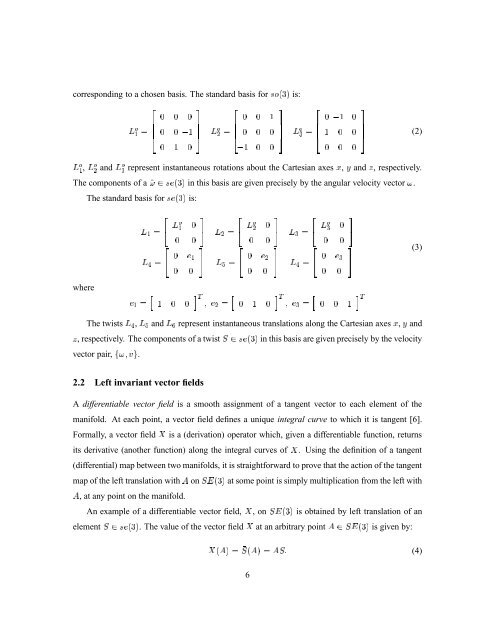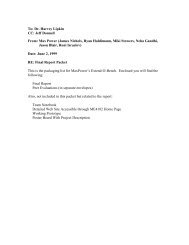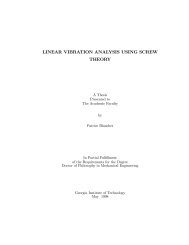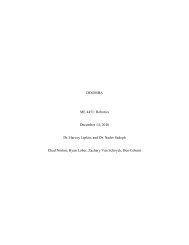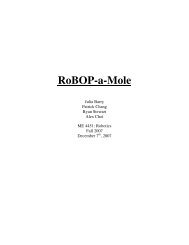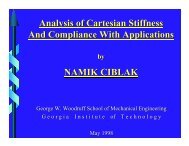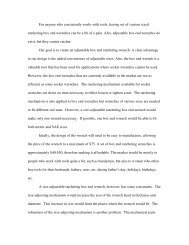New metrics for rigid body motion interpolation - helix
New metrics for rigid body motion interpolation - helix
New metrics for rigid body motion interpolation - helix
You also want an ePaper? Increase the reach of your titles
YUMPU automatically turns print PDFs into web optimized ePapers that Google loves.
corresponding to a chosen basis. The standard basis <strong>for</strong> so(3) is:<br />
2 3<br />
3<br />
0 0 0<br />
0 0 1<br />
6<br />
7<br />
6<br />
7<br />
L o 1 = 0 0 ,1<br />
0 0 0<br />
6<br />
4<br />
2<br />
7<br />
5 Lo 2 = 6<br />
4<br />
0 1 0<br />
,1 0 0<br />
2<br />
7<br />
5 Lo 3 = 6<br />
4<br />
0 ,1 0<br />
1 0 0<br />
0 0 0<br />
3<br />
7<br />
5<br />
(2)<br />
L o, 1 Lo and 2 Lo 3<br />
represent instantaneous rotations about the Cartesian axes x, y and z, respectively.<br />
The components of a ^! 2 se(3) in this basis are given precisely by the angular velocity vector !.<br />
The standard basis <strong>for</strong> se(3) is:<br />
2<br />
3<br />
2<br />
L 1 = 4 Lo 1<br />
0<br />
5 L2 = 4 Lo 2<br />
0<br />
5 L3 = 4 Lo 3<br />
0<br />
0 0<br />
0 0<br />
0 0<br />
L 4 =<br />
2<br />
4 0 e 1<br />
0 0<br />
3<br />
5 L 5 =<br />
2<br />
4 0 e 2<br />
0 0<br />
3<br />
3<br />
5 L 4 =<br />
2<br />
2<br />
4 0 e 3<br />
0 0<br />
3<br />
5<br />
3<br />
5<br />
(3)<br />
where<br />
e 1 =<br />
h<br />
1 0 0<br />
i T<br />
; e2 =<br />
h<br />
0 1 0<br />
i T<br />
; e3 =<br />
h<br />
0 0 1<br />
i T<br />
The twists L 4 , L 5 and L 6 represent instantaneous translations along the Cartesian axes x, y and<br />
z, respectively. The components of a twist S 2 se(3) in this basis are given precisely by the velocity<br />
vector pair, f!; vg.<br />
2.2 Left invariant vector fields<br />
A differentiable vector field is a smooth assignment of a tangent vector to each element of the<br />
manifold. At each point, a vector field defines a unique integral curve to which it is tangent [6].<br />
Formally, a vector field X is a (derivation) operator which, given a differentiable function, returns<br />
its derivative (another function) along the integral curves of X. Using the definition of a tangent<br />
(differential) map between two manifolds, it is straight<strong>for</strong>ward to prove that the action of the tangent<br />
map of the left translation with A on SE(3) at some point is simply multiplication from the left with<br />
A, at any point on the manifold.<br />
An example of a differentiable vector field, X, onSE(3) is obtained by left translation of an<br />
element S 2 se(3). The value of the vector field X at an arbitrary point A 2 SE(3) is given by:<br />
X(A) = S(A) =AS: (4)<br />
6


